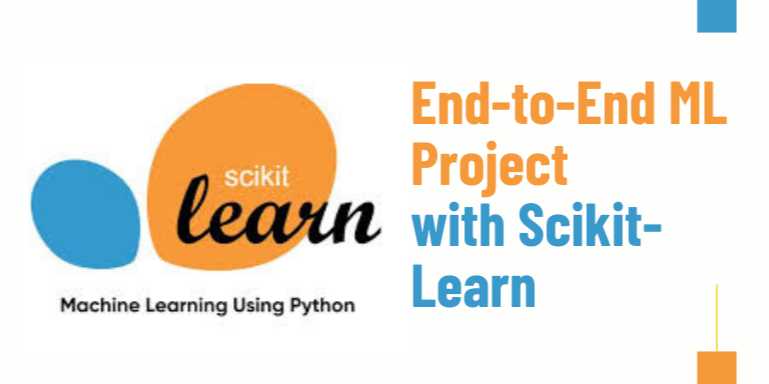A Complete End-to-End Machine Learning Project with Scikit-Learn

📖 Chapter 1: Understanding the ML Workflow and Scikit-Learn Ecosystem
🧠 Introduction
Machine Learning (ML) has rapidly transitioned from a niche
research domain into a critical component of mainstream data-driven
applications. From recommendation engines to credit scoring systems and
predictive maintenance, ML is at the core of modern AI-powered tools. However,
successful ML implementation isn't just about creating complex algorithms; it's
about mastering a repeatable, scalable, and interpretable workflow — one
that transitions seamlessly from experimentation to production.
In this chapter, we’ll cover the fundamental machine
learning workflow and introduce you to Scikit-Learn, one of the most
popular Python libraries for classical ML. Whether you're just starting or
looking to formalize your process, understanding this workflow will help you
build robust and maintainable ML solutions.
🎯 What Is an ML Workflow?
An ML workflow is a structured pipeline of tasks
required to take raw data and convert it into actionable insights using machine
learning. It ensures consistency, reproducibility, and alignment with business
objectives.
🔄 Typical ML Workflow
Overview
|
Stage |
Task |
|
1. Problem Framing |
Define the goal of the
ML system |
|
2. Data Collection |
Acquire and
organize relevant data |
|
3. Data
Preprocessing |
Clean, transform, and
prepare data |
|
4. Feature Engineering |
Create and
select useful input variables |
|
5. Model Selection |
Choose algorithms
suited to the task |
|
6. Model Training |
Fit model to
training data |
|
7. Model Evaluation |
Assess performance on
unseen data |
|
8. Hyperparameter Tuning |
Optimize
model parameters |
|
9. Deployment |
Package model for use
in production |
|
10. Monitoring |
Evaluate
performance over time |
🧩 1. Problem Framing
Everything begins with understanding the problem.
- What
are we trying to predict?
- What
data is available?
- Is
it a classification, regression, or clustering task?
Example:
|
Domain |
Problem |
ML Task |
|
Healthcare |
Predict patient
readmission |
Classification |
|
Real Estate |
Estimate
housing prices |
Regression |
|
E-commerce |
Group customers by
behavior |
Clustering |
Clear problem framing helps choose the right evaluation
metric and algorithm later on.
🗂️ 2. Data Collection
Data is the backbone of machine learning. The better the
data, the more accurate and generalizable your model.
Sources may include:
- Public
datasets (UCI, Kaggle, etc.)
- APIs
- Internal
databases
- IoT
devices or logs
Once collected, data should be stored securely and
version-controlled for reproducibility.
🔍 3. Data Preprocessing
Raw data often contains noise, missing values, or inconsistent
formats. Preprocessing ensures the model receives clean, numerical, and
consistent inputs.
Key tasks:
- Handling
missing values (SimpleImputer)
- Converting
categorical variables (OneHotEncoder, OrdinalEncoder)
- Scaling
(StandardScaler, MinMaxScaler)
- Detecting
and handling outliers
Scikit-Learn provides pipelines to chain these
transformations efficiently.
🧠 4. Feature Engineering
Features are the fuel of ML models. Quality features often
matter more than the algorithm itself.
- Create
interaction features
- Convert
timestamps to seasonal categories
- Encode
domain knowledge into features
- Reduce
dimensionality using PCA
Scikit-Learn’s PolynomialFeatures, FunctionTransformer, and
integration with ColumnTransformer make this process seamless.
⚙️ 5. Model Selection
Model choice depends on:
- The
nature of the target variable
- Data
volume
- Interpretability
needs
- Training
time constraints
Common models in Scikit-Learn:
|
Task |
Algorithm |
Scikit-Learn Class |
|
Classification |
Logistic Regression |
LogisticRegression |
|
Classification |
Random Forest |
RandomForestClassifier |
|
Regression |
Linear Regression |
LinearRegression |
|
Regression |
Gradient
Boosting |
GradientBoostingRegressor |
|
Clustering |
KMeans |
KMeans |
📈 6. Model Training
Model training means fitting your selected algorithm to the
training data.
Scikit-Learn follows the fit–predict–score API:
python
model.fit(X_train,
y_train)
predictions
= model.predict(X_test)
accuracy
= model.score(X_test, y_test)
This unified syntax applies across nearly all estimators.
📏 7. Model Evaluation
We evaluate models to estimate generalization performance.
Scikit-Learn provides:
- cross_val_score()
for k-fold validation
- classification_report()
for precision, recall, and F1
- Regression
metrics: mean_squared_error, r2_score
Choosing the right metric is essential — for example,
accuracy is misleading with imbalanced classes.
🔍 8. Hyperparameter
Tuning
Many models have knobs called hyperparameters that
influence learning.
Scikit-Learn allows:
- GridSearchCV:
Exhaustive search
- RandomizedSearchCV:
Efficient sampling
These tools find the best model configuration via
cross-validation.
🚀 9. Deployment &
Persistence
Scikit-Learn models can be saved using:
- joblib
- pickle
For example:
python
import
joblib
joblib.dump(model,
'model.pkl')
You can then load this model in a web API (Flask, FastAPI)
or dashboard (Streamlit, Gradio).
🧪 10. Monitoring and
Feedback
Once deployed, you must:
- Track
input data drift
- Measure
prediction accuracy over time
- Retrain
periodically
Use tools like:
- MLflow
for experiment tracking
- Evidently
AI for model monitoring
- Prometheus
+ Grafana for system metrics
🛠️ Overview:
Scikit-Learn's Core Interfaces
|
Functionality |
Class |
Description |
|
Estimator |
.fit() |
Trains the model |
|
Predictor |
.predict() |
Makes
predictions |
|
Transformer |
.transform() |
Alters data (e.g.,
scale, encode) |
|
Evaluator |
.score() |
Returns
performance metric |
|
Pipeline |
Pipeline() |
Combines steps into a
workflow |
|
Model Tuning |
GridSearchCV() |
Hyperparameter
optimization |
🧾 Advantages of Using
Scikit-Learn
- Clean,
consistent API across all models
- Excellent
documentation
- Easy
integration with pandas, NumPy, Matplotlib
- Compatible
with advanced libraries (e.g., XGBoost, LightGBM)
- Perfect
for quick prototyping and production-ready workflows
💡 Summary
Understanding the machine learning workflow is
foundational for any successful AI project. It brings structure, clarity, and
repeatability to your modeling process. Scikit-Learn stands out as a top-tier
toolkit that covers every major phase of this workflow.
By mastering Scikit-Learn's tools and APIs, you not only
become proficient in classical ML methods, but also gain an architectural
mindset — critical for scaling ML applications in real-world settings.
In the next chapter, we will start applying this theory by
collecting and exploring real data. But first, here’s a quick knowledge
reinforcement with key FAQs.
FAQs
1. What is meant by an end-to-end machine learning project?
An end-to-end machine learning project includes all stages of development, from defining the problem and gathering data to training, evaluating, and deploying the model in a real-world environment.
2. Why should I use Scikit-Learn for an end-to-end ML project?
Scikit-Learn is widely adopted due to its simplicity, clean API, and comprehensive set of tools for data preprocessing, modeling, evaluation, and tuning, making it ideal for full ML workflows.
3. Can I use Scikit-Learn for deep learning projects?
Scikit-Learn is not designed for deep learning. For such use cases, you should use frameworks like TensorFlow or PyTorch. However, Scikit-Learn is perfect for classical ML tasks like classification, regression, and clustering.
4. How do I handle missing values using Scikit-Learn?
You can use SimpleImputer from sklearn.impute to fill in missing values with mean, median, or most frequent values as part of a pipeline.
5. What is the advantage of using a pipeline in Scikit-Learn?
Pipelines help you bundle preprocessing and modeling steps together, ensuring consistency during training and testing and reducing the chance of data leakage.
6. How can I evaluate my model’s performance properly?
You should split your data into training and test sets or use cross-validation to assess performance. Scikit-Learn offers metrics like accuracy, F1-score, RMSE, and R² depending on the task.
7. Is it possible to deploy Scikit-Learn models into production?
Yes, models trained with Scikit-Learn can be serialized using joblib or pickle and deployed using tools like Flask, FastAPI, or cloud services such as AWS and Google Cloud.
8. What is cross-validation and why is it useful?
Cross-validation is a method of splitting the data into multiple folds to ensure the model generalizes well. It helps detect overfitting and gives a more reliable performance estimate.
9. How do I tune hyperparameters with Scikit-Learn?
You can use GridSearchCV or RandomizedSearchCV to automate hyperparameter tuning and select the best model configuration based on performance metrics.
10. Can Scikit-Learn handle categorical variables?
Yes, using transformers like OneHotEncoder or OrdinalEncoder, and integrating them within a ColumnTransformer, Scikit-Learn can preprocess both categorical and numerical features efficiently.
Tutorials are for educational purposes only, with no guarantees of comprehensiveness or error-free content; TuteeHUB disclaims liability for outcomes from reliance on the materials, recommending verification with official sources for critical applications.
Explore Other Libraries
Please allow ads on our site
Kindly log in to use this feature. We’ll take you to the login page automatically.
Login
Join Our Community Today
Ready to take your education and career to the next level? Register today and join our growing community of learners and professionals.

Your experience on this site will be improved by allowing cookies. Read Cookie Policy
Your experience on this site will be improved by allowing cookies. Read Cookie Policy
Comments(2)